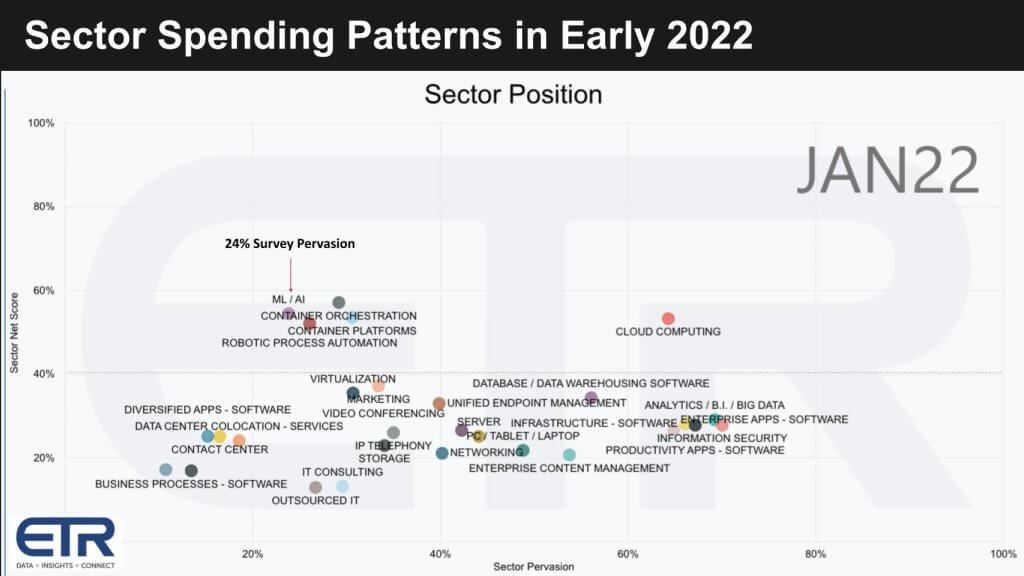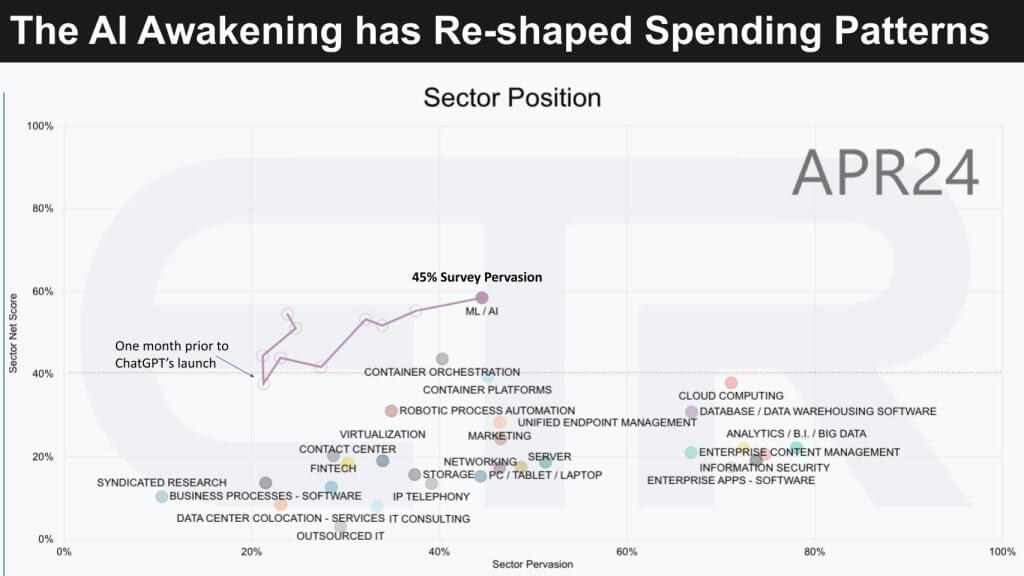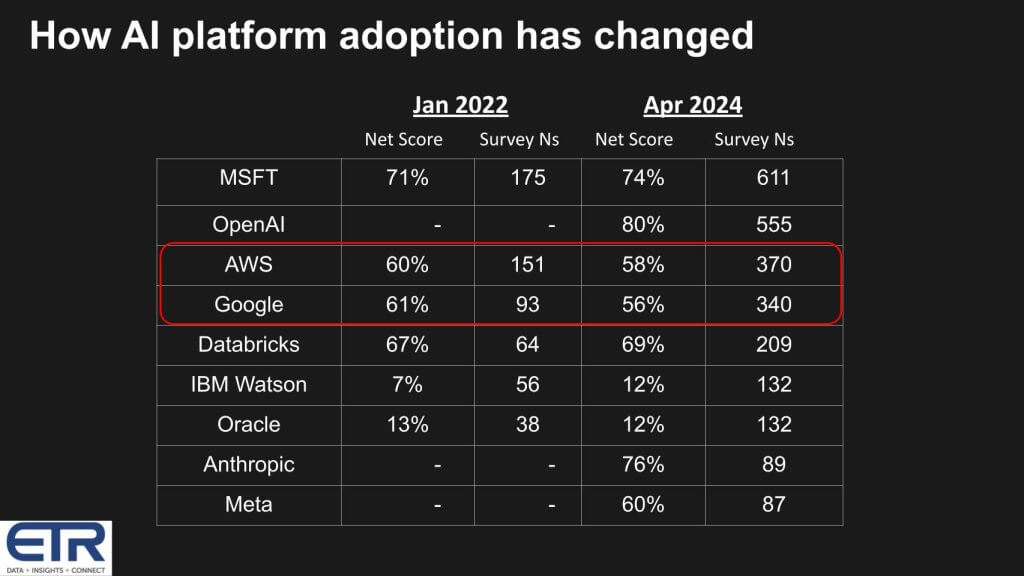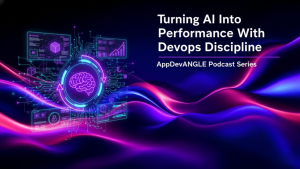In another big week we saw the AI battles continue to escalate. Google reorged to better focus on AI, Meta’s Llama 3 was released, TSM is doubling its manufacturing capacity for NVIDIA high end chips, Samsung got a $6.4B tranche of the chips act money, a Microsoft paper describes VASA-1 that turns photos into a kinda creepy talking head, Mistral is doing a $1/2B raise at more than 2X its last valuation from just four months ago and SAS introduced industry models in a sign that demand for domain-specific AI is taking shape. Since the AI awakening in November of 2022, the spending climate for enterprise tech has transformed. Customers are scraping money from other budgets to fund AI and running experiments in the desperate race for monetization. Names that were virtually unknown in early 2022 – like OpenAI, Meta Llama and Anthropic, are vying with the cloud scale companies to get a piece of the pie. And notably, based on the latest ETR survey data, while Google remains a distant third in cloud computing spend overall, it has dramatically accelerated its position in the all important AI sector, closing the gap with AWS.
In this (abbreviated) Breaking Analysis we’ll show you how the spending patterns have changed since early 2022, prior to the launch of ChatGPT and we’ll share where customers are putting their bets on AI platforms.
Spending on Innovation was More Balanced in Early 2022
Let’s take a look back at the spending climate in 2022. The chart below shows Net Score or spending momentum on the vertical axis. The horizontal axis is Pervasion, which represents the number of customers spending in specific sector divided by the total N in the survey of around 1,800 IT decision makers (ITDMs). That red line at 40 percent on the vertical axis represents a highly elevated Net Score.

The following key points are important:
- At the time, there were four sectors above that magic 40 percent mark including AI, containers, RPA, and cloud computing.
- Note that the Pervasion of the ML/AI sector at the time was 24%, meaning 24% of the customers in the survey responded with details of how they were spending on ML/AI.
- This data tells us there was a healthy balance of spending in the key growth areas mentioned above.
Survey Shows AI Sector Penetration has Doubled
When we fast forward to 2024 the picture changes dramatically with ML/AI momentum outpacing other sectors and nearly doubling its account pervasiveness.

Here are the key takeaways:
- The ML/AI sector began to decelerate coming out of COVID and bottomed one month before ChatGPT.
- ML/AI has been up and to the right since.
- The more significant pattern is shown by the behavior of the other sectors which have been pushed down to or below the 40 percent mark.
- The striking data point is the survey Pervasion for AI has gone from 24% to 45% in just over two years.
As we’ve reported AI is stealing budget from other sectors of the tech economy. And generally the monetization hasn’t been there or at least not to the point where it’s causing the overall spending climate to grow. In fact just the opposite is happening, i.e. the spending outlook remains challenging overall. So until AI projects start to throw off enough cash to pay for themselves or other initiatives we expect the macro to be challenging.
Google’s AI Makes Notable Gains in Account Penetration
Let’s take a look at how spending on various AI platforms has changed in the last two years.

In the table above we look at AI adoption by platform vendor over the past two years. We have synthesized data from two pivotal points in the ETR surveys: one from January 2022 and a subsequent snapshot from April 2024. For each time period we show Net Score and the number of respondents citing they’re using a specific platform (Ns).
Net Score Methodology: ETR’s proprietary Net Score metric is captured each quarter in a time series. It is an indicator of the proportion of customers increasing their investment in a given AI platform. This metric is the result of a subtraction process where the percentage of customers curtailing their spending or disengaging from the platform is deducted from those intensifying their investments or commencing new engagements.
Key Observations:
- The technology spending landscape has witnessed a significant shift with AI and machine learning (ML) capturing a more substantial “market share,” in the survey which aligns with the sectors’ burgeoning importance.
- Notable in 2022 is the absence of prominent entities such as OpenAI, Anthropic, and Meta’s Llama, juxtaposed with the robust net scores of incumbents AWS and Google, followed by Microsoft’s substantial lead.
- A comparison of the ‘N’, representing the number of respondents utilizing specific platforms, reveals AWS’s margin over Google in the ML/AI sector has narrowed from 60% to a mere 8% as of the latest data, suggesting a much tighter race between these two firms.
- While Microsoft and OpenAI exhibit staggering net scores and respondent counts, new entrants like Anthropic and Meta Llama have emerged with significant ‘Ns’ and Net Scores, disrupting the market status quo.
- Traditional ML platforms from Databricks remains prominent but is undergoing an extension with the recently announced DBRX which is not reflected in the current survey data.
- Snowflake is not included in this sector but our understanding is ETR is adding their platform into the mix.
Consolidated Insights:
- AI’s ascendancy is obvious, overshadowing other sectors and attracting new investments and focus from customers.
- The industry is experiencing a dynamic shift with new players gaining rapid attention and traditional giants like Oracle and IBM showing growth, albeit at a slower pace.
- There’s an increasing trend of AI integration into broader applications and systems, not just as a standalone purchase but as an intrinsic component, as seen with companies like Cisco and Juniper.
Bottom Line: The AI sector is in the throes of an accelerated evolution but uncertainty remains. Our research indicates that as AI continues to mature it will become more entrenched with various existing technology sectors. Spending patterns are becoming increasingly dynamic and will likely be volatile as ROI is still elusive in many accounts. We see this wave as not merely a transition but a transformation, and believe that customers must remain agile with a platform mindset to navigate the changing landscape of AI. Specifically, we believe customers must develop an internal architecture that is people and process focused with requisite change management protocols. Customers must be able to quickly test, prove and adopt new technologies and innovations as they hit the market. Given the high levels of funding and CAPEX investments, the market is likely to remain highly competitive with dizzying optionality. A platform mindset will allow firms to optimize for specific use cases based on the performance, cost, energy and time to value requirements specific to their organizational edicts. AI spending momentum and penetration from the survey data will continue to serve as a barometer for innovation and market position in the foreseeable future.
Image: Art Fusion



